ABSTRACT
Dragon fruit is among the most nutritious and wonderful exotic fruits in the world. Dragon fruit production is a profitable enterprise and a promising means of raising the income of farmers in the Philippines. The continuously increasing land area planted to dragon fruit indicates its great potential as a commercial crop. Since its introduction, Research and Development endeavors continue to brighten the horizon of dragon fruit in the Philippines. The support of government agencies such as the Departments of Science and Technology (DOST), Department of Agriculture (DA) and Local Government Units (LGU) in supporting the local farming communities, Bureau of Agriculture and Fisheries Product Standards (BAFPS) in the development of the Philippine National Standard for fresh dragon fruit classification and grading played a vital role in developing the dragon fruit industry as a money making business. Major constraints were identified such as low yield, prevalence of insect pests and diseases, short shelf life of fruits, and marketing problems. Despite increasing volume of harvest, the fruits have been plagued by piercing and sucking insects causing unsightly damage to the fruit peel with the flesh still intact. Consequently, this rendered the fruit unmarketable due to its unattractive appearance. These problems have prompted researchers to develop processed products like jam, jelly, puree, juice, wine and cider vinegar as value adding technologies to save the damaged dragon fruit from going into waste. An IPM program utilizing environmentally friendly control measures that will reduce risk to human health and environment must be developed to address emerging problems on pests and diseases. Minimizing post-harvest losses can increase meeting the demands for fresh fruits. Along with this, post-harvest infrastructure and management must be given ample attention. Dragon fruits in the Philippines are slowly finding its way to the international market which calls for the adoption of an aggressive marketing strategy and development of export infrastructure giving consideration to the quality standard set by potential importing countries.
Keywords: Dragon Fruit, Integrated Pest Management, Supply Chain
INTRODUCTION
Dragon fruit is one of the most widely distributed members of the cactaceae family, and are now found in six continents They are native to the tropical regions of Central and South America where they are known as pitaya or pitahaya (Mizrahi et al., 1997). It is an edible vine or climbing cacti species that belongs to two different genera Hylocereus and Selenicereus (Crane and Balerdi, 2004)
Fruit production is a profitable enterprise and a promising means of raising the income of farmers in the Philippines. While there are large scales of other fruit crops such as mango, banana, pineapple, citrus and other crops in the market, dragon fruit is now setting a market potential in the country (Pinoy Farmer, 2007). The dragon fruit was introduced in the Philippines in the 1900s through trading and exchange of goods by the Spaniards and Filipinos (Aquino, 2005). The crop is also grown in Vietnam, Thailand, Malaysia and Taiwan. The Philippines is now gaining a competitive edge through mass propagation and production mostly in Cavite, Davao, Bukidnon and Ilocos Region.
For the last six years, the area planted to dragon fruit in the Philippines has increased. From 182 hectares in 2012, as of 2017 the country’s total area planted to dragon fruit is 450 hectares (PSA, 2018). Ilocos region has the highest production area planted to dragon fruit with 200 hectares which only started with backyard production of Mrs. Editha Dacuycuy in 2005 (Eusebio and Alaban, 2018).
Since its introduction in Cavite Philippines in the early `90s as a commercial crop, farmers became interested and started to plant the dragon fruit in their farms. From then on, a lot of farmers planted dragon fruit because of its nutritional value and the promise it brings in terms of profit. The area planted with the fruit in Cavite has increased tremendously because of its commercial value sometimes at the expense of cutting coffee trees and conversion of pineapple plantations. Commercial and backyard farms in Cavite can now produce as much as 10-15 tons per hectare (Silan, personal communication, July 2003). From 16.5 ha of land already planted to dragon fruit which produced 412 tons in 2006, it is estimated the area planted with dragon fruit in Cavite alone has increased to more than 35 hectares in 2018 (Personal communication May 31, 2019. The fruit is highly seasonal and the harvest season starts from April while peak season is from August to September. Despite increasing volume of harvest, the fruits have been plagued by piercing and sucking insects causing unsightly damage to the fruit peel with the flesh still intact. Consequently, this rendered the fruit unmarketable due to its unattractive appearance.
Farmers have claimed that about 35% of the total yield is lost due to this damage. In addition, the fruit is non-climacteric (TFNet, 2004) and does not undergo normal ripening after harvest, as most fruits do, and could not, therefore, be stored at ambient temperature for more than ten (10) days (Zee et al., 2004). Thus, at peak harvest, there is a market glut and surplus is wasted.
Uses and nutritional value
Dragon fruit is rich in fiber, vitamin C and minerals. It is also rich in phytoalbumins known for its antioxidant properties. The fruit can be eaten as dessert, juice, cocktails and ice cream mix ingredients. Most pitayas are consumed fresh; however, the frozen pulp may be used to make ice cream, yogurt, jelly, preserves, marmalade, juice, candy and pastries. Unopened flower buds can be cooked and eaten as a vegetable. The pitaya fruit is well known for its health benefits, unique taste and spectacular appearance. They are rich in antioxidants and have exceptionally high content of soluble fiber. Besides being a good source of vitamin C, studies have also proven that pitaya fruit is effective in preventing cancer and diabetes. Freshly cut stems and flowers have a spasmolytic effect on the coronary vessels and promote blood circulation. They also contain the heart tonic captine and used to combat anemia. Pitaya seeds contain oil that is a mild laxative (Jacobs, 1999).
Fruiting season
Dragon fruit plants produce fruits almost all-year round, especially if irrigation and fertilizers are provided. In other countries, optimal time to harvest Hylocereus undatus fruit was 28 to 30 days after flowering at full color development. These fruit are nonclimactic and were found to maintain their quality for at least two weeks when stored at 14℃ (Nerd et al., 1999). They also found that pigment development in red-fleshed varieties paralleled skin color development.
Under Cavite climate, the fruiting season is from June to October, white fleshed pitaya matures within 42 to 45 days from the appearance of flower buds for maximum sweetness. Harvesting indices include full red coloration of the terminal petal and swelling of the navel end to the point of cracking. Pitaya is a long day plant requiring 10 hours or more of daylight in order to produce flowers and fruit.
Harvesting for optimum sweetness preferred by local consumers takes 40 to 45 days from flowering. Vietnam and Thai farmers harvest as short as 27-32 days as their consumers prefer and sweet -sour tasting fruit. Pitaya harvested at optimum sweetness (40-45 days from flowering) can be stored up to 2 weeks using household refrigerators.
Maturity indices for dragon fruit
A common index of maturity is skin color change to almost full red . Harvest indices include color, SSC, TA and days from flowering. The dragon fruit is a large, oblong fruit with a red peel and large green scales. The scales turn yellow upon ripening. Skin color begins to change 25 to 30 days from flowering in both H. undatus and H. polyhizus. At about the same time, flesh firmness approaches a minimum and eating quality approaches a maximum 33 to 37 days after flowering (Nerd et al., 1999). The flesh of different species can vary from white to various hues of red to very dark red. As the fruit matures, acidity reaches a peak just as the skin color change occurs, then declines 25 to 30 days after flowering in which SSC increases to about 14% .
In the Philippines, the fruit are usually harvested 10 to 15 days after the fruits turns red. The fruit are harvested at the full color stage when the skin is pinkish red to full red.

Harvesting and yield
Harvesting is done by manually picking each mature fruit. Dragon plant is a high yielder, with a yield of 10-15 t/ha, provided good cultural practices are adopted. . Dragon fruit can be harvested between 42 to 45 days after flower initiation.
Pitaya harvesting in the Philippines can come in 6-12 waves or cycles per year. Each fruit can weigh from 150-600 grams and depending on the age of the crop, location and management practices employed (Rodeo et al. 2019). The plant bears about 30 to 50 fruits per growing season. Leather gloves and long sleeved shirts are recommended for harvesting thorny varieties. Plastic covering the fruit are first removed then fruits are handpicked from the plants using a pruning shear.

Post-harvest practices.
Handling. Poor post-harvest handling could affect the quality of texture and flavor of the fruit. Therefore, management of post-harvest is critical for all growers. Being a delicate fruit, care must be taken in handling the transport of fruits from the farm to the market.
The fruits are collected using crates and carefully brought to the grading and packaging room by a tractor.

Sorting and grading. The fruits are graded on the basis of size , color and quality of the skin. Fruits which show symptoms of disease and insect damage are discarded. In other countries such fruits are graded by size: extra-large >500 g. (1.1 lb) , large 380 to 500 g (0.84 to 1.1 lb), regular 300 to 400 g. (0.66 to 0.84 lb), medium 260 to 300 g. (0.57 to 0.66 lb), small <260 g). Fruit produced in the Philippines for local markets are graded by number of fruits 16, 20, 24, or 26 per 10 kg (220 lb.) cardboard box.

Packaging for domestic market.
Fiberboard carton. The fruits are packed in boxes with 10 kg capacity. The fruits are carefully lined inside the boxes to avoid injury while transporting.

Plastic crates. To provide adequate ventilation dragon fruits are also being packed in plastic crates . Plastic crates require initial cost but it is more durable, easy to handle, clean and reusable.
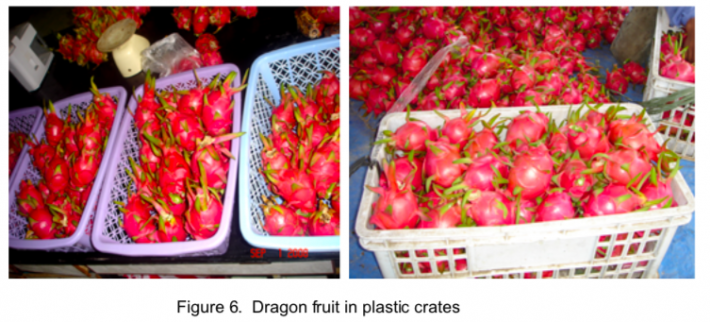
Storage
After harvest, fruits can be stored for 3-4 days at ambient temperature and 1-2 weeks at 20oC or 14 oC, respectively. Dragon fruit is non-climacteric and its physico-chemical characteristics and sensory properties starts to decline slightly after harvesting. Dragon fruit has a storage life of about 14 days at 10 o C (50oF) while at 5oC (41oF) and 90% relative humidity a storage life of 17 days can be achieved if harvested 30 to 35 days from flowering.
Market for Philippine dragon fruit
Local market. After harvest, dragon fruit in the Philippines are usually being delivered to three types of direct buyers namely: Retailers, Processors and Wholesaler. The retailers go to the farm to buy dragon fruit to be sold to local consumers in the fruit stands along the roadsides. The processors directly get their raw materials from the farm and processed the fruits into jam, jelly, puree, juice and wines. There are also times wherein processors get their supplies from the retailers. The wholesalers are those who get fruit from the farm in big volumes usually 3 to 4 MT. per delivery. They usually distribute dragon fruit to trading post and supermarkets in manila. They also sell some of their stocks to retailers who then sell the fruits to the general public. The retailers and consumers buy dragon fruit on a cash basis while wholesalers practice consignment (Figure 7).
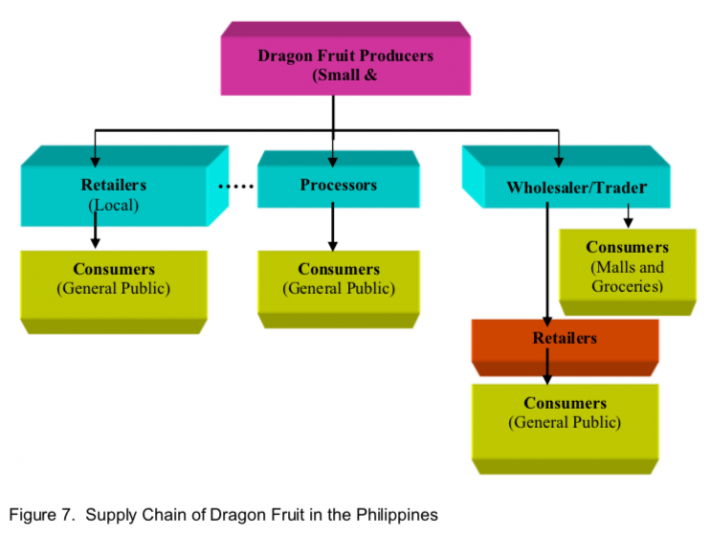
From the farms, the fruits are transported and delivered to wholesalers and retailers. Some retailers and consolidators go directly to the farms to pick up their orders. Dragon fruits can now be seen on display along highways and local markets in Cavite. Farm gate price is PhP 50.00-80 Php while retailers sell the fruits at Php 120 to PhP 180 per kilo.
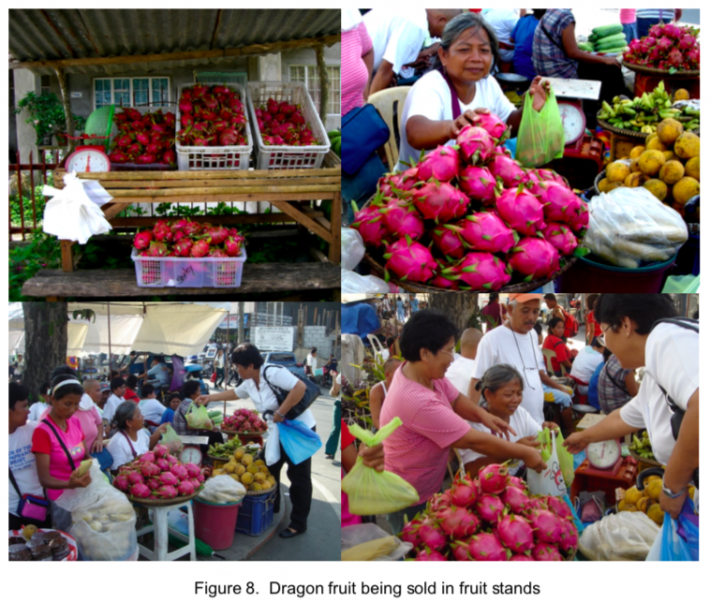
Export market. Over a decade since a scaly bright pink fruit that reminded some of a dragon found its way to the Philippines, tons of dragon fruit are now being produced in various parts of the country, providing a source of profits and livelihood to countryside entrepreneurs. On August 26, the first shipment of more than 600 kilos of Philippine premium dragon fruit landed on Richmond City in British Columbia, Canada through fruit and vegetable importer Pahoa Produce Ltd. (Sunstar online, 2016)
Setting quality standards
The development of the Philippine National Standard for fresh dragon fruits classification and grading, PNS/BAFPS 115:2013 was undertaken by the Bureau of Agriculture and Fisheries Product Standards (BAFPS) in order to reflect the recent technology developments in the industry, and the need for its harmonization with ASEAN standards and Codex requirements in Heavy Metals, Pesticide Residues and Hygiene.
A Technical Committee and Sub-Committee (SC) were organized by Bureau of Agriculture and Fisheries Product Standards (BAFPS) through Special Orders No. 289 series of 2012 to generate and update the data and formulate the PNS for Dragon Fruit. BAFPS, in collaboration with the TC conducted technical reviews and public consultations in the three major islands of the country prior to the finalization of the standard.
PNS/BAFPS 115:2013 aims to provide common understanding on the scope, definitions, minimum requirements, classification, size classification, tolerances, sampling, packaging, and marking and labeling of Dragon (www.bafps.da.gov.ph)
Based on the PNS, dragon fruit is classified according to three classes as follows: Extra class, or the fruits with superior quality; Class I, or the fruits with good quality but slight defects; and Class II, or the fruits which do not qualify for inclusion in the higher classes but satisfy the minimum requirements. Size is determined by the weight of the fruit (Table 1). The weight of dragon fruit must not be less than 230 g.

Dragon fruit processing
A team of researchers composed of Dr. Teddy F. Tepora, Dr. Edna A. Vida and Dr. Fe N. Dimero from Cavite State University (CvSU) has developed high-value processed products from dragon fruit such as dragon fruit puree, jelly, ready-to-drink juice, jam, cider vinegar and wine. The products was developed through a research fund granted by the Department of Science and Technology (DOST), Technology Innovation for Commercialization (TechniCom) and the Philippine Council for Industry , Energy, Emerging Technology Research and Development (PCIEERD) (Tepora et al., 2013).
Other dragon fruit products have also been developed by REFMAD Farm in Ilocos Norte owned by Mrs. Editha Dacuycuy such as dragon fruit ice cream, dragon fruit energy tea, dragon fruit cookies, dragon fruit pandesal, dragon fruit jam, dragon fruit wine and dragon fruit soap. Recently, Refmad Farms also developed an “all-natural and organic” dragon fruit freeze-dried extract powder that can be used for smoothies, teas and food ingredients (The Manila Times, August 30, 2019)

Major issues and problems that significantly affect the quality and safety of dragon fruit
Insect pests
Mechanical injury, damaged caused by pests and diseases are the common problems in dragon fruit production in the Philippines. Mechanical injury leads to development of sunken areas. More mature fruit are more susceptible to mechanical injury. Splitting is a problem in fruit that have received rainfall or excessive irrigation during ripening since harvest time in the Philippines falls during rainy season.
The major pests include fruit flies, mealybugs, diridonid bugs and tussock moth in Cavite area. (Tepora, 2008). In Ilocos Norte, the most common pests are the oriental fruit fly and red ants (https://www.freshplaza.com).
In a study conducted by Estigoy & Estigoy (2015), insects associated with dragon fruit production indicated predominance of Tachinid fly, all three species of ants ( Paratrechina sp ., Solenopsis sp. and Tapinoma sp.) and aphids during the vegetative stage; only three species of ants and fruit fly ( Bactrocera sp.) were observed during the flowering stage.
Oriental fruit fly (Bactrocera dorsalis Hendel, Diptera: Tephritidae). This insect can be considered as serious pest of night blooming cactus as it can cause serious damage when left unattended. Large number of flies can be observed after heavy rain.
The female pierces or sting the maturing green or reddening fruit and lays a clutch of white, oval shaped eggs. Affected fruits rot rapidly and the skin around the sting marks form discoloration. Egg and larvae were also observed in the holes located in the fruit apex causing flower termination. This pest was also present in other crops such as papaya, mango and rambutan
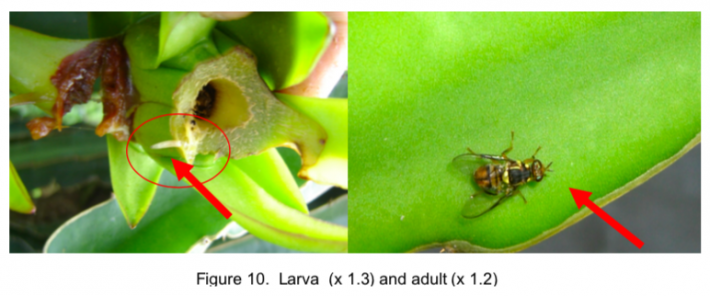
Mealybug (Ferrisia virgata Cockerell, Hemiptera: Pseudococcidae). Small, soft bodied, sap sucking insect covered with powder or filament white wax. It is short legged and rarely mobile. It is commonly attached to the surface of the leaves or stem where it sucks the plant sap. On dragon fruit, they are found near the tip of the fruit crown and on the surface of the fruit.
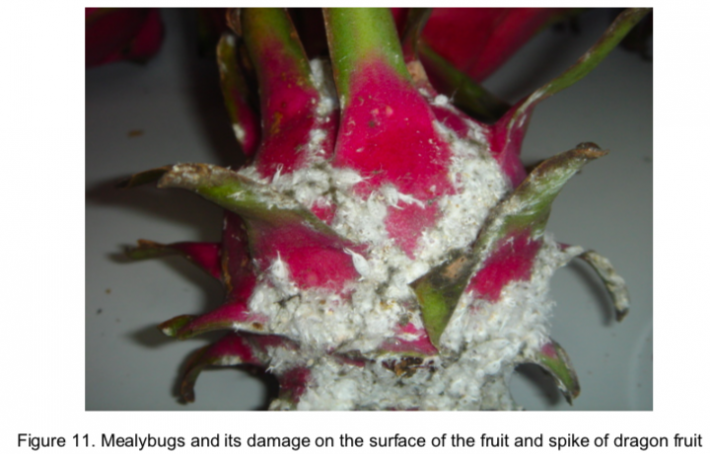
Diridonid Bug (Unidentified, Hemiptera: Dinidoridae). The nymphs and adults suck the growing points and fruits. Adults and nymphs can be seen on the shoots and young fruits. Damage on young fruit is characterized by small punctures which later develop into a scabby area which is caused by piercing into the skin of the fruit. Damaged become more distinct as the fruit ripens. Small rusty circular spots can be observed all over the fruit which affects fruit quality.
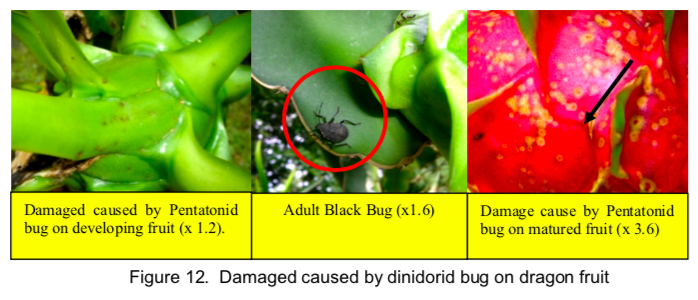
Tussock Moth. This pest eats the soft part of the fruit spikes and crown. It can also feeds on surface of young developing fruit leaving scars on the fruit. It lays its egg on the surface of the leaves.

Diseases
Dragon fruit stems, leaves and fruits can be infected with diseases such as soft rot and scab. Propagules of pathogenic fungi and bacteria are abundant in the atmosphere and on the surface of fruits as they approach maturity in the field. Some pathogenic organisms are not capable of directly penetrating the cuticle and epidermis of the hosts, but if they gain entry through an injury or natural opening, these organisms may cause devastating rots of mature produce. Diseases are major constraints in dragon fruit production that need to be addressed. These diseases are infectious and could affect all plants in the field when environmental condition is favorable. Bacterial or fungal disease of commercial significance has been studied by Mamaril ( 2010) in the Philippines.
1. Anthracnose, caused by Colletotrichum gloeosporioides (Penzig) Penzig & Sacc
Symptoms. Disease on dragon fruit stem was characterized with an early symptom of yellow specks (Figure 14a) which turned to distinct circular reddish to brown lesion with dark concentric acervuli (Figure 14b). The lesions later became slightly sunken; water- soaked with chlorotic margin (Figure 14c) and then dried up resulting to shot hole. The fruit had a soft, brown, circular and sunken rot which was superficial. These spots may enlarge and coalesce (Figure 14d).

2. Blight, caused by Aspergillus fumigatus (Fres)
Symptoms. The disease starts with a soft watery lesion found at the margins of the stem. It later develops into dry and necrotic tissue with the formation of the dark spore on the surface (Figure 15a).
On the fruit, noted were initial symptoms of small brown lesions that coalesced, turning fruits with blighted scales (Figure 15b).
.png)
3. Dry rot, caused by Penicillium glabrum (Wehmer)
Symptoms. It had an initial symptom of developing small, circular spots on the fruit with gray to bluish powdery masses of spores (Figure 16a) that eventually led to dry black rot on the whole fruit (Figure 16b).
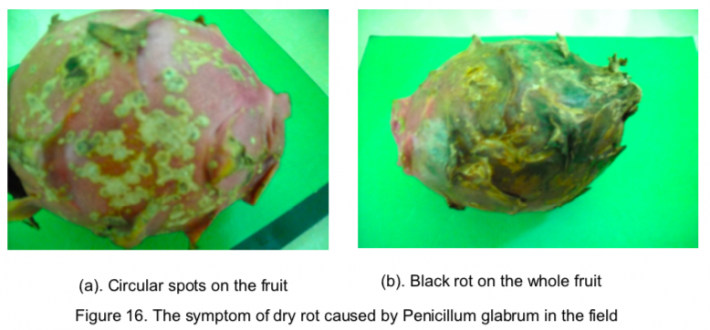
4. Wilting, caused by Fusarium sporotrichioides (Sherb)
Symptoms. The symptom was wilting with water soaked texture which started at the tip and spread to the developing fruit. The fungal growth was evident to the rotting flower (Figure 17).
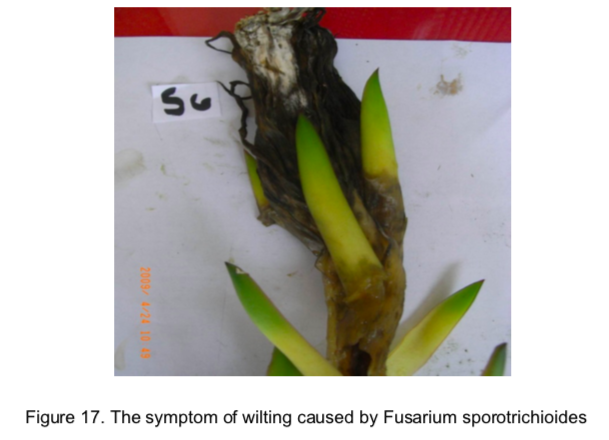
5. Blotch, caused by Fusarium oxysporum (Sny and Han)
Symptoms. The symptom starts with small lesion and later turns to soft brown blotches which spread on the superficial part of the fruit (Figure 18).

6. Soft Rot, caused by Enterobacter cloacae
Symptom. A water soaked tissue appeared at the end of the stem and rapidly enlarged in length and becoming soft and mushy. Foul smell was produced by rotting tissues (Figure 19a).
Infected fruit becomes watery, soft and with foul smell; the rot started at the apex of the fruit and spread rapidly infecting the whole fruit (Figure190b).
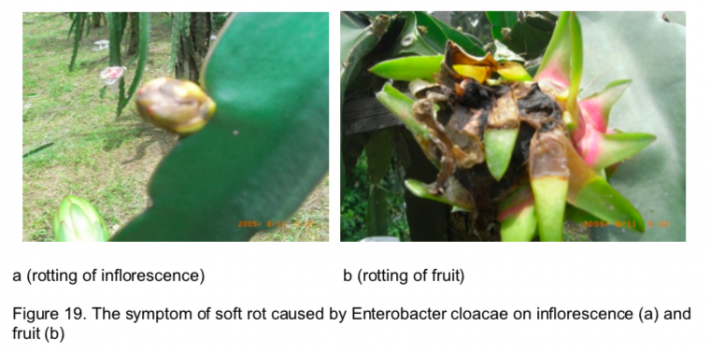
7. Rot, caused by Serratia marsecens
Symptom. It exhibited yellowing of the stem and progress to a tender and slightly watery texture which lengthened as it creeps.
In the flower, yellowing of the developing inflorescence is evident, the affected part was subsequently detached hence fruit setting was obliterated (Figure 20).
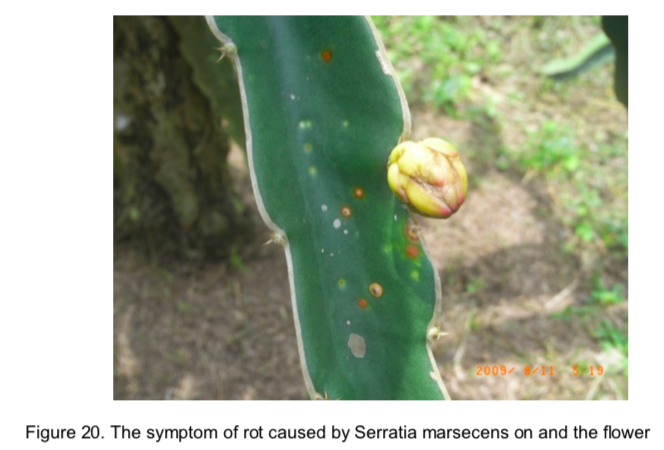
Other problems
Because of the market potential of dragon fruit, more farmers are now growing without a definite plan and prospects. Only very few farmers have their own regular market for the products. Other farmers are just producing resulting to selling of their produce at a lower price, thereby, affecting the marketability of those produced by other farmers. Dragon fruit production requires a relatively high investment costs. Only little percentage of the farmer’s population can now go on commercial production because of lack of institutional support. Cost of infrastructure and Technical knowledge in all aspect of dragon fruit production is also lacking for most of the local farmers.
Off -season production of dragon fruit
In a three- month comparative study conducted by Leonardo T. Pascua of Mariano Marcos State University, Batac Ilocos Norte, using 26-watt CFL and 6-watt LED, it was found that the 160 posts dragon cactus, planted in a 1,000 square meter-field, using 26-watt CFL could yield 729.6 kg and earn a net income of P60,329. Moreover, the area lighted with 6-watt LED produced 560 kg and earned a net income of P21, 086 (www.pcaarrd.dost.gov.ph).
Opportunities for Dragon Fruit Industry in the Philippines
The growing local and global demand for dragon fruit makes it a very promising industry in the Philippines. It gives so many opportunities in terms of business ventures, research, development and extension collaborations.
Dragon fruit growing has been expanding in different areas in the Philippines. These plantations, have attracted a steady stream of tourists and plant lovers, boosting the agriculture tourism potentials of these areas. The REFMAD Farms in Burgos, Ilocos Norte, on the other hand, is one of the largest if not the earliest dragon fruit farms in the Philippines. Has become one of the tourism sites endorsed by the provincial government of Ilocos Norte (Gimutao, 2019).
Silans Agri Farm in Indang, Cavite is also a recipient of funding support from the Philippine Council for Agriculture, Aquatic and Natural Resources Research and Development (PCAARRD) through the project Science for the Convergence of Agriculture and Tourisms (Sci-CAT). The project aims to develop the farm into an Agri-Eco tourism site which showcase different farming technologies including dragon fruit.
Research in areas such as cultural management, pest’s management, post-harvest processing and product development has been initiated by researchers from different universities such as Cavite State University in Indang, Cavite and Mariano Marcos State University in Ilocos Norte. There are many other researchable areas that can be explored on dragon fruit. Eusebio and Alaban (2018) reported that the current pest management on dragon fruit is fragmented or independently applied in managing specific pests and diseases. The available technologies must be validated through conduct of research to develop an integrated management approach) towards a sustainable control strategy for dragon fruit pests and diseases. The Postharvest Horticulture Training and Research Center (PHTRC) of the College of Agriculture and Food Science (CAFS), University of the Philippines at Los Baños (UPLB) is one of the institutions constantly working on postharvest research of dragon fruit in the Philippines (Rodeo et al, 2019) to maintain its quality before it reach the consumers. .
Information, Education and Communication (IEC) materials has been developed and now being used to disseminate information on dragon fruit production as part of extension activities in the university. Silan’s Agrifarm has been designated as learning site by the Agricultural Training Institute (ATI), the extension and training arm of the Philippine Department of Agriculture.
In terms of trade and marketing, aside from local market, dragon fruit has just started to be traded in export market. The development of Philippine National Standard for dragon fruit is indicative that the Philippines is ready to supply dragon fruit in the global market. The development of new products as value adding technologies for dragon fruit has been adopted by some farmers who invested on processing as source of income.
CONCLUSION
The increasing demand for dragon fruit has broadened the horizon for Research development and extension for this very promising fruit. The demand for dragon fruit is expected to increase as this delicious fruit becomes better known in other markets. As the demand for dragon fruit in the Philippine market exceeds the supply, it created an opportunity to the farmers to commercially grow dragon fruit on a large scale.
An Integrated Pest Management Program, must be develop to address emerging concerns on pest and diseases problems. The IPM program should focus on environment friendly control measures that will reduce risk to human health and environment.
Post-harvest practices are critical to successful marketing of dragon fruit. Harvesting and Post-Harvest handling operations for dragon fruit in the Philippines is influenced by technical and extra technical factors such as cultural requirements, stage of harvest, inherent product characteristics, prevailing ambient environment, and transport and storage requirements. Minimizing post-harvest losses can increase meeting the demands for fresh fruits. Along with this, post-harvest infrastructure and management must be given ample attention.
To explore new markets, there is a need to adopt aggressive marketing strategy and start to develop export infrastructure giving consideration to the quality standard set by potential importing countries. Strong collaborations between university, public and private funding institutions and non-government institution to stay strategically connected to the needs of the farmers, consumers and the entire dragon fruit industry.
REFERENCES
Aquino, M. U. 2005. The potential of the dragon fruit. BAR Digest: Research and Development. Vol 7. No.3.
Crane, J. H and Balerdi C. F 2004. Pitaya Growing in Florida Landscape. University of Florida, Institute of Food and Agricultural Sciences
Eusebio, E. J. and Alaban, MCS. 2018. Current Status of Dragon Fruit and Its Prospects in the Philippines. FFTC Agriculture Policy Platform. Food and Fertilizer Technology Center for the Asian ND Pacific Region. a.p.fftc.agnet.org: Accessed June 2, 2019.
Estigoy, J.H., Estigoy, M.A.S. (2015) Population Dynamics of Insects Associated with Dragon Fruit ( Hylocereus sp.). Journal of Agricultural Technology
Gimutao, K. , 2019. Unleashing the potentials of farm tourism to improve the lives of Southeast Asian farmers https://fanssea.searca.org/news-and-updates/fanssea-news/unleashing-the-potentials-of-farm-tourism-to-improve-the-lives-of-southeast-asian-farmers Accessed June 2, 2019
https://www.freshplaza.com)/article/2146886/philippines-dragon-fruit-production-not-meeting-demand/ Accessed June 2, 2019
https://www.sunstar.com.ph/article/94930: Accessed June 2, 2019. Philippine dragon fruit reaches Canadian market. August 29, 2016
Jacobs, D. 1999. Pitaya: A Potential New Crop for Australia. The Australian New Crops Newsletter 29 (16.3)
Mamaril, C. A. 2010. Isolation, Identification and Pathogenecity of Organisms Associated with Dragon Fruit (Hylocereus undatus, Haw Britton and Rose. Unpublished Thesis. Cavite State University Indang, Cavite.
Mizrahi, Y. and A. Nerd and P.S. Nobel. 1997. Cacti as crops. Hort. Rev. 18:291-319.
Nerd, A. and Y. Mizrahi. 1997. Reproductive biology of cactus fruit crops. Hort. Rev. 18:321-346.
Nerd, A. and Y. Mizrahi. 1999. The effect of ripening stage of fruit quality after storage of yellow pitaya. Postharv. Biol. Technol. 15:99-105.
Nerd, A., F. Gutman and Y. Mizrahi. 1999. Ripening and postharvest behaviour of fruits of two Hylocereus species (Cactaceae). Postharv. Biol. Technol. 17:39-45.
Pascua, L.T., M.E. Pascua, and M.L.S. Gabriel. 2015. Dragon Fruit Production and Marketing in the Philippines: Its Status, Constraints and Prospects. In: Jiang, Y.L., P.C. Liu, and P.H. Huang (eds.). Improving pitaya production and marketing. Food and Fertlizer Technology Center, Taipei, Taiwan. pp. 47-63
Philippine National Standard. Bureau of Agriculture and Fisheries Product Standard. 115:2013
Rodeo, A.J.D., Castro, A.C., Esguerra, E. B. 2019. Postharvest Handling of Dragon Fruit (Hylocereus spp) in the Philippines.
Silan, E. 2007. Personal Interview with the Candidate for Magsasaka Siyentista for Banana and Dragon Fruit by the STARRDEC.
Tepora, T. F 2007. Insect Pests Associated with Dragon Fruit (Hylocereus undatus, Haw Briton and Rose) in the Province of Cavite. Unpublished Research. Cavite State University Indang, Cavite.
Tepora, T.F, Dimero, F. N., Vida, E.A. 2013. Pilot Testing of Dragon Fruit Processed Products Jam Jelly, Puree and Juice Drink. Unpublished Terminal Report. Cavite State University, Indang, Cavite.
The Manila Times. PH-grown dragon fruit hits Canadian market by August 30, 2016
TFNet. 2004. Dragon fruit. International Tropical Fruits Network: Malaysia
www.pcaarrd.dost.gov.ph/home/portal/index.php/quick-information-dispatch...
Zee, F., Yen, C. R. and M. Nishina. 2004. Pitaya. Fruits and Nuts – 9. Cooperative Extension Service: Hawaii
Date submitted: September 10, 2019
Reviewed, edited and uploaded: October 19, 2019 |


Problems and Opportunities of Dragon Fruit Production in the Philippines
ABSTRACT
Dragon fruit is among the most nutritious and wonderful exotic fruits in the world. Dragon fruit production is a profitable enterprise and a promising means of raising the income of farmers in the Philippines. The continuously increasing land area planted to dragon fruit indicates its great potential as a commercial crop. Since its introduction, Research and Development endeavors continue to brighten the horizon of dragon fruit in the Philippines. The support of government agencies such as the Departments of Science and Technology (DOST), Department of Agriculture (DA) and Local Government Units (LGU) in supporting the local farming communities, Bureau of Agriculture and Fisheries Product Standards (BAFPS) in the development of the Philippine National Standard for fresh dragon fruit classification and grading played a vital role in developing the dragon fruit industry as a money making business. Major constraints were identified such as low yield, prevalence of insect pests and diseases, short shelf life of fruits, and marketing problems. Despite increasing volume of harvest, the fruits have been plagued by piercing and sucking insects causing unsightly damage to the fruit peel with the flesh still intact. Consequently, this rendered the fruit unmarketable due to its unattractive appearance. These problems have prompted researchers to develop processed products like jam, jelly, puree, juice, wine and cider vinegar as value adding technologies to save the damaged dragon fruit from going into waste. An IPM program utilizing environmentally friendly control measures that will reduce risk to human health and environment must be developed to address emerging problems on pests and diseases. Minimizing post-harvest losses can increase meeting the demands for fresh fruits. Along with this, post-harvest infrastructure and management must be given ample attention. Dragon fruits in the Philippines are slowly finding its way to the international market which calls for the adoption of an aggressive marketing strategy and development of export infrastructure giving consideration to the quality standard set by potential importing countries.
Keywords: Dragon Fruit, Integrated Pest Management, Supply Chain
INTRODUCTION
Dragon fruit is one of the most widely distributed members of the cactaceae family, and are now found in six continents They are native to the tropical regions of Central and South America where they are known as pitaya or pitahaya (Mizrahi et al., 1997). It is an edible vine or climbing cacti species that belongs to two different genera Hylocereus and Selenicereus (Crane and Balerdi, 2004)
Fruit production is a profitable enterprise and a promising means of raising the income of farmers in the Philippines. While there are large scales of other fruit crops such as mango, banana, pineapple, citrus and other crops in the market, dragon fruit is now setting a market potential in the country (Pinoy Farmer, 2007). The dragon fruit was introduced in the Philippines in the 1900s through trading and exchange of goods by the Spaniards and Filipinos (Aquino, 2005). The crop is also grown in Vietnam, Thailand, Malaysia and Taiwan. The Philippines is now gaining a competitive edge through mass propagation and production mostly in Cavite, Davao, Bukidnon and Ilocos Region.
For the last six years, the area planted to dragon fruit in the Philippines has increased. From 182 hectares in 2012, as of 2017 the country’s total area planted to dragon fruit is 450 hectares (PSA, 2018). Ilocos region has the highest production area planted to dragon fruit with 200 hectares which only started with backyard production of Mrs. Editha Dacuycuy in 2005 (Eusebio and Alaban, 2018).
Since its introduction in Cavite Philippines in the early `90s as a commercial crop, farmers became interested and started to plant the dragon fruit in their farms. From then on, a lot of farmers planted dragon fruit because of its nutritional value and the promise it brings in terms of profit. The area planted with the fruit in Cavite has increased tremendously because of its commercial value sometimes at the expense of cutting coffee trees and conversion of pineapple plantations. Commercial and backyard farms in Cavite can now produce as much as 10-15 tons per hectare (Silan, personal communication, July 2003). From 16.5 ha of land already planted to dragon fruit which produced 412 tons in 2006, it is estimated the area planted with dragon fruit in Cavite alone has increased to more than 35 hectares in 2018 (Personal communication May 31, 2019. The fruit is highly seasonal and the harvest season starts from April while peak season is from August to September. Despite increasing volume of harvest, the fruits have been plagued by piercing and sucking insects causing unsightly damage to the fruit peel with the flesh still intact. Consequently, this rendered the fruit unmarketable due to its unattractive appearance.
Farmers have claimed that about 35% of the total yield is lost due to this damage. In addition, the fruit is non-climacteric (TFNet, 2004) and does not undergo normal ripening after harvest, as most fruits do, and could not, therefore, be stored at ambient temperature for more than ten (10) days (Zee et al., 2004). Thus, at peak harvest, there is a market glut and surplus is wasted.
Uses and nutritional value
Dragon fruit is rich in fiber, vitamin C and minerals. It is also rich in phytoalbumins known for its antioxidant properties. The fruit can be eaten as dessert, juice, cocktails and ice cream mix ingredients. Most pitayas are consumed fresh; however, the frozen pulp may be used to make ice cream, yogurt, jelly, preserves, marmalade, juice, candy and pastries. Unopened flower buds can be cooked and eaten as a vegetable. The pitaya fruit is well known for its health benefits, unique taste and spectacular appearance. They are rich in antioxidants and have exceptionally high content of soluble fiber. Besides being a good source of vitamin C, studies have also proven that pitaya fruit is effective in preventing cancer and diabetes. Freshly cut stems and flowers have a spasmolytic effect on the coronary vessels and promote blood circulation. They also contain the heart tonic captine and used to combat anemia. Pitaya seeds contain oil that is a mild laxative (Jacobs, 1999).
Fruiting season
Dragon fruit plants produce fruits almost all-year round, especially if irrigation and fertilizers are provided. In other countries, optimal time to harvest Hylocereus undatus fruit was 28 to 30 days after flowering at full color development. These fruit are nonclimactic and were found to maintain their quality for at least two weeks when stored at 14℃ (Nerd et al., 1999). They also found that pigment development in red-fleshed varieties paralleled skin color development.
Under Cavite climate, the fruiting season is from June to October, white fleshed pitaya matures within 42 to 45 days from the appearance of flower buds for maximum sweetness. Harvesting indices include full red coloration of the terminal petal and swelling of the navel end to the point of cracking. Pitaya is a long day plant requiring 10 hours or more of daylight in order to produce flowers and fruit.
Harvesting for optimum sweetness preferred by local consumers takes 40 to 45 days from flowering. Vietnam and Thai farmers harvest as short as 27-32 days as their consumers prefer and sweet -sour tasting fruit. Pitaya harvested at optimum sweetness (40-45 days from flowering) can be stored up to 2 weeks using household refrigerators.
Maturity indices for dragon fruit
A common index of maturity is skin color change to almost full red . Harvest indices include color, SSC, TA and days from flowering. The dragon fruit is a large, oblong fruit with a red peel and large green scales. The scales turn yellow upon ripening. Skin color begins to change 25 to 30 days from flowering in both H. undatus and H. polyhizus. At about the same time, flesh firmness approaches a minimum and eating quality approaches a maximum 33 to 37 days after flowering (Nerd et al., 1999). The flesh of different species can vary from white to various hues of red to very dark red. As the fruit matures, acidity reaches a peak just as the skin color change occurs, then declines 25 to 30 days after flowering in which SSC increases to about 14% .
In the Philippines, the fruit are usually harvested 10 to 15 days after the fruits turns red. The fruit are harvested at the full color stage when the skin is pinkish red to full red.
Harvesting and yield
Harvesting is done by manually picking each mature fruit. Dragon plant is a high yielder, with a yield of 10-15 t/ha, provided good cultural practices are adopted. . Dragon fruit can be harvested between 42 to 45 days after flower initiation.
Pitaya harvesting in the Philippines can come in 6-12 waves or cycles per year. Each fruit can weigh from 150-600 grams and depending on the age of the crop, location and management practices employed (Rodeo et al. 2019). The plant bears about 30 to 50 fruits per growing season. Leather gloves and long sleeved shirts are recommended for harvesting thorny varieties. Plastic covering the fruit are first removed then fruits are handpicked from the plants using a pruning shear.
Post-harvest practices.
Handling. Poor post-harvest handling could affect the quality of texture and flavor of the fruit. Therefore, management of post-harvest is critical for all growers. Being a delicate fruit, care must be taken in handling the transport of fruits from the farm to the market.
The fruits are collected using crates and carefully brought to the grading and packaging room by a tractor.
Sorting and grading. The fruits are graded on the basis of size , color and quality of the skin. Fruits which show symptoms of disease and insect damage are discarded. In other countries such fruits are graded by size: extra-large >500 g. (1.1 lb) , large 380 to 500 g (0.84 to 1.1 lb), regular 300 to 400 g. (0.66 to 0.84 lb), medium 260 to 300 g. (0.57 to 0.66 lb), small <260 g). Fruit produced in the Philippines for local markets are graded by number of fruits 16, 20, 24, or 26 per 10 kg (220 lb.) cardboard box.
Packaging for domestic market.
Fiberboard carton. The fruits are packed in boxes with 10 kg capacity. The fruits are carefully lined inside the boxes to avoid injury while transporting.
Plastic crates. To provide adequate ventilation dragon fruits are also being packed in plastic crates . Plastic crates require initial cost but it is more durable, easy to handle, clean and reusable.
Storage
After harvest, fruits can be stored for 3-4 days at ambient temperature and 1-2 weeks at 20oC or 14 oC, respectively. Dragon fruit is non-climacteric and its physico-chemical characteristics and sensory properties starts to decline slightly after harvesting. Dragon fruit has a storage life of about 14 days at 10 o C (50oF) while at 5oC (41oF) and 90% relative humidity a storage life of 17 days can be achieved if harvested 30 to 35 days from flowering.
Market for Philippine dragon fruit
Local market. After harvest, dragon fruit in the Philippines are usually being delivered to three types of direct buyers namely: Retailers, Processors and Wholesaler. The retailers go to the farm to buy dragon fruit to be sold to local consumers in the fruit stands along the roadsides. The processors directly get their raw materials from the farm and processed the fruits into jam, jelly, puree, juice and wines. There are also times wherein processors get their supplies from the retailers. The wholesalers are those who get fruit from the farm in big volumes usually 3 to 4 MT. per delivery. They usually distribute dragon fruit to trading post and supermarkets in manila. They also sell some of their stocks to retailers who then sell the fruits to the general public. The retailers and consumers buy dragon fruit on a cash basis while wholesalers practice consignment (Figure 7).
From the farms, the fruits are transported and delivered to wholesalers and retailers. Some retailers and consolidators go directly to the farms to pick up their orders. Dragon fruits can now be seen on display along highways and local markets in Cavite. Farm gate price is PhP 50.00-80 Php while retailers sell the fruits at Php 120 to PhP 180 per kilo.
Export market. Over a decade since a scaly bright pink fruit that reminded some of a dragon found its way to the Philippines, tons of dragon fruit are now being produced in various parts of the country, providing a source of profits and livelihood to countryside entrepreneurs. On August 26, the first shipment of more than 600 kilos of Philippine premium dragon fruit landed on Richmond City in British Columbia, Canada through fruit and vegetable importer Pahoa Produce Ltd. (Sunstar online, 2016)
Setting quality standards
The development of the Philippine National Standard for fresh dragon fruits classification and grading, PNS/BAFPS 115:2013 was undertaken by the Bureau of Agriculture and Fisheries Product Standards (BAFPS) in order to reflect the recent technology developments in the industry, and the need for its harmonization with ASEAN standards and Codex requirements in Heavy Metals, Pesticide Residues and Hygiene.
A Technical Committee and Sub-Committee (SC) were organized by Bureau of Agriculture and Fisheries Product Standards (BAFPS) through Special Orders No. 289 series of 2012 to generate and update the data and formulate the PNS for Dragon Fruit. BAFPS, in collaboration with the TC conducted technical reviews and public consultations in the three major islands of the country prior to the finalization of the standard.
PNS/BAFPS 115:2013 aims to provide common understanding on the scope, definitions, minimum requirements, classification, size classification, tolerances, sampling, packaging, and marking and labeling of Dragon (www.bafps.da.gov.ph)
Based on the PNS, dragon fruit is classified according to three classes as follows: Extra class, or the fruits with superior quality; Class I, or the fruits with good quality but slight defects; and Class II, or the fruits which do not qualify for inclusion in the higher classes but satisfy the minimum requirements. Size is determined by the weight of the fruit (Table 1). The weight of dragon fruit must not be less than 230 g.
Dragon fruit processing
A team of researchers composed of Dr. Teddy F. Tepora, Dr. Edna A. Vida and Dr. Fe N. Dimero from Cavite State University (CvSU) has developed high-value processed products from dragon fruit such as dragon fruit puree, jelly, ready-to-drink juice, jam, cider vinegar and wine. The products was developed through a research fund granted by the Department of Science and Technology (DOST), Technology Innovation for Commercialization (TechniCom) and the Philippine Council for Industry , Energy, Emerging Technology Research and Development (PCIEERD) (Tepora et al., 2013).
Other dragon fruit products have also been developed by REFMAD Farm in Ilocos Norte owned by Mrs. Editha Dacuycuy such as dragon fruit ice cream, dragon fruit energy tea, dragon fruit cookies, dragon fruit pandesal, dragon fruit jam, dragon fruit wine and dragon fruit soap. Recently, Refmad Farms also developed an “all-natural and organic” dragon fruit freeze-dried extract powder that can be used for smoothies, teas and food ingredients (The Manila Times, August 30, 2019)
Major issues and problems that significantly affect the quality and safety of dragon fruit
Insect pests
Mechanical injury, damaged caused by pests and diseases are the common problems in dragon fruit production in the Philippines. Mechanical injury leads to development of sunken areas. More mature fruit are more susceptible to mechanical injury. Splitting is a problem in fruit that have received rainfall or excessive irrigation during ripening since harvest time in the Philippines falls during rainy season.
The major pests include fruit flies, mealybugs, diridonid bugs and tussock moth in Cavite area. (Tepora, 2008). In Ilocos Norte, the most common pests are the oriental fruit fly and red ants (https://www.freshplaza.com).
In a study conducted by Estigoy & Estigoy (2015), insects associated with dragon fruit production indicated predominance of Tachinid fly, all three species of ants ( Paratrechina sp ., Solenopsis sp. and Tapinoma sp.) and aphids during the vegetative stage; only three species of ants and fruit fly ( Bactrocera sp.) were observed during the flowering stage.
Oriental fruit fly (Bactrocera dorsalis Hendel, Diptera: Tephritidae). This insect can be considered as serious pest of night blooming cactus as it can cause serious damage when left unattended. Large number of flies can be observed after heavy rain.
The female pierces or sting the maturing green or reddening fruit and lays a clutch of white, oval shaped eggs. Affected fruits rot rapidly and the skin around the sting marks form discoloration. Egg and larvae were also observed in the holes located in the fruit apex causing flower termination. This pest was also present in other crops such as papaya, mango and rambutan
Mealybug (Ferrisia virgata Cockerell, Hemiptera: Pseudococcidae). Small, soft bodied, sap sucking insect covered with powder or filament white wax. It is short legged and rarely mobile. It is commonly attached to the surface of the leaves or stem where it sucks the plant sap. On dragon fruit, they are found near the tip of the fruit crown and on the surface of the fruit.
Diridonid Bug (Unidentified, Hemiptera: Dinidoridae). The nymphs and adults suck the growing points and fruits. Adults and nymphs can be seen on the shoots and young fruits. Damage on young fruit is characterized by small punctures which later develop into a scabby area which is caused by piercing into the skin of the fruit. Damaged become more distinct as the fruit ripens. Small rusty circular spots can be observed all over the fruit which affects fruit quality.
Tussock Moth. This pest eats the soft part of the fruit spikes and crown. It can also feeds on surface of young developing fruit leaving scars on the fruit. It lays its egg on the surface of the leaves.
Diseases
Dragon fruit stems, leaves and fruits can be infected with diseases such as soft rot and scab. Propagules of pathogenic fungi and bacteria are abundant in the atmosphere and on the surface of fruits as they approach maturity in the field. Some pathogenic organisms are not capable of directly penetrating the cuticle and epidermis of the hosts, but if they gain entry through an injury or natural opening, these organisms may cause devastating rots of mature produce. Diseases are major constraints in dragon fruit production that need to be addressed. These diseases are infectious and could affect all plants in the field when environmental condition is favorable. Bacterial or fungal disease of commercial significance has been studied by Mamaril ( 2010) in the Philippines.
1. Anthracnose, caused by Colletotrichum gloeosporioides (Penzig) Penzig & Sacc
Symptoms. Disease on dragon fruit stem was characterized with an early symptom of yellow specks (Figure 14a) which turned to distinct circular reddish to brown lesion with dark concentric acervuli (Figure 14b). The lesions later became slightly sunken; water- soaked with chlorotic margin (Figure 14c) and then dried up resulting to shot hole. The fruit had a soft, brown, circular and sunken rot which was superficial. These spots may enlarge and coalesce (Figure 14d).
2. Blight, caused by Aspergillus fumigatus (Fres)
Symptoms. The disease starts with a soft watery lesion found at the margins of the stem. It later develops into dry and necrotic tissue with the formation of the dark spore on the surface (Figure 15a).
On the fruit, noted were initial symptoms of small brown lesions that coalesced, turning fruits with blighted scales (Figure 15b).
3. Dry rot, caused by Penicillium glabrum (Wehmer)
Symptoms. It had an initial symptom of developing small, circular spots on the fruit with gray to bluish powdery masses of spores (Figure 16a) that eventually led to dry black rot on the whole fruit (Figure 16b).
4. Wilting, caused by Fusarium sporotrichioides (Sherb)
Symptoms. The symptom was wilting with water soaked texture which started at the tip and spread to the developing fruit. The fungal growth was evident to the rotting flower (Figure 17).
5. Blotch, caused by Fusarium oxysporum (Sny and Han)
Symptoms. The symptom starts with small lesion and later turns to soft brown blotches which spread on the superficial part of the fruit (Figure 18).
6. Soft Rot, caused by Enterobacter cloacae
Symptom. A water soaked tissue appeared at the end of the stem and rapidly enlarged in length and becoming soft and mushy. Foul smell was produced by rotting tissues (Figure 19a).
Infected fruit becomes watery, soft and with foul smell; the rot started at the apex of the fruit and spread rapidly infecting the whole fruit (Figure190b).
7. Rot, caused by Serratia marsecens
Symptom. It exhibited yellowing of the stem and progress to a tender and slightly watery texture which lengthened as it creeps.
In the flower, yellowing of the developing inflorescence is evident, the affected part was subsequently detached hence fruit setting was obliterated (Figure 20).
Other problems
Because of the market potential of dragon fruit, more farmers are now growing without a definite plan and prospects. Only very few farmers have their own regular market for the products. Other farmers are just producing resulting to selling of their produce at a lower price, thereby, affecting the marketability of those produced by other farmers. Dragon fruit production requires a relatively high investment costs. Only little percentage of the farmer’s population can now go on commercial production because of lack of institutional support. Cost of infrastructure and Technical knowledge in all aspect of dragon fruit production is also lacking for most of the local farmers.
Off -season production of dragon fruit
In a three- month comparative study conducted by Leonardo T. Pascua of Mariano Marcos State University, Batac Ilocos Norte, using 26-watt CFL and 6-watt LED, it was found that the 160 posts dragon cactus, planted in a 1,000 square meter-field, using 26-watt CFL could yield 729.6 kg and earn a net income of P60,329. Moreover, the area lighted with 6-watt LED produced 560 kg and earned a net income of P21, 086 (www.pcaarrd.dost.gov.ph).
Opportunities for Dragon Fruit Industry in the Philippines
The growing local and global demand for dragon fruit makes it a very promising industry in the Philippines. It gives so many opportunities in terms of business ventures, research, development and extension collaborations.
Dragon fruit growing has been expanding in different areas in the Philippines. These plantations, have attracted a steady stream of tourists and plant lovers, boosting the agriculture tourism potentials of these areas. The REFMAD Farms in Burgos, Ilocos Norte, on the other hand, is one of the largest if not the earliest dragon fruit farms in the Philippines. Has become one of the tourism sites endorsed by the provincial government of Ilocos Norte (Gimutao, 2019).
Silans Agri Farm in Indang, Cavite is also a recipient of funding support from the Philippine Council for Agriculture, Aquatic and Natural Resources Research and Development (PCAARRD) through the project Science for the Convergence of Agriculture and Tourisms (Sci-CAT). The project aims to develop the farm into an Agri-Eco tourism site which showcase different farming technologies including dragon fruit.
Research in areas such as cultural management, pest’s management, post-harvest processing and product development has been initiated by researchers from different universities such as Cavite State University in Indang, Cavite and Mariano Marcos State University in Ilocos Norte. There are many other researchable areas that can be explored on dragon fruit. Eusebio and Alaban (2018) reported that the current pest management on dragon fruit is fragmented or independently applied in managing specific pests and diseases. The available technologies must be validated through conduct of research to develop an integrated management approach) towards a sustainable control strategy for dragon fruit pests and diseases. The Postharvest Horticulture Training and Research Center (PHTRC) of the College of Agriculture and Food Science (CAFS), University of the Philippines at Los Baños (UPLB) is one of the institutions constantly working on postharvest research of dragon fruit in the Philippines (Rodeo et al, 2019) to maintain its quality before it reach the consumers. .
Information, Education and Communication (IEC) materials has been developed and now being used to disseminate information on dragon fruit production as part of extension activities in the university. Silan’s Agrifarm has been designated as learning site by the Agricultural Training Institute (ATI), the extension and training arm of the Philippine Department of Agriculture.
In terms of trade and marketing, aside from local market, dragon fruit has just started to be traded in export market. The development of Philippine National Standard for dragon fruit is indicative that the Philippines is ready to supply dragon fruit in the global market. The development of new products as value adding technologies for dragon fruit has been adopted by some farmers who invested on processing as source of income.
CONCLUSION
The increasing demand for dragon fruit has broadened the horizon for Research development and extension for this very promising fruit. The demand for dragon fruit is expected to increase as this delicious fruit becomes better known in other markets. As the demand for dragon fruit in the Philippine market exceeds the supply, it created an opportunity to the farmers to commercially grow dragon fruit on a large scale.
An Integrated Pest Management Program, must be develop to address emerging concerns on pest and diseases problems. The IPM program should focus on environment friendly control measures that will reduce risk to human health and environment.
Post-harvest practices are critical to successful marketing of dragon fruit. Harvesting and Post-Harvest handling operations for dragon fruit in the Philippines is influenced by technical and extra technical factors such as cultural requirements, stage of harvest, inherent product characteristics, prevailing ambient environment, and transport and storage requirements. Minimizing post-harvest losses can increase meeting the demands for fresh fruits. Along with this, post-harvest infrastructure and management must be given ample attention.
To explore new markets, there is a need to adopt aggressive marketing strategy and start to develop export infrastructure giving consideration to the quality standard set by potential importing countries. Strong collaborations between university, public and private funding institutions and non-government institution to stay strategically connected to the needs of the farmers, consumers and the entire dragon fruit industry.
REFERENCES
Aquino, M. U. 2005. The potential of the dragon fruit. BAR Digest: Research and Development. Vol 7. No.3.
Crane, J. H and Balerdi C. F 2004. Pitaya Growing in Florida Landscape. University of Florida, Institute of Food and Agricultural Sciences
Eusebio, E. J. and Alaban, MCS. 2018. Current Status of Dragon Fruit and Its Prospects in the Philippines. FFTC Agriculture Policy Platform. Food and Fertilizer Technology Center for the Asian ND Pacific Region. a.p.fftc.agnet.org: Accessed June 2, 2019.
Estigoy, J.H., Estigoy, M.A.S. (2015) Population Dynamics of Insects Associated with Dragon Fruit ( Hylocereus sp.). Journal of Agricultural Technology
Gimutao, K. , 2019. Unleashing the potentials of farm tourism to improve the lives of Southeast Asian farmers https://fanssea.searca.org/news-and-updates/fanssea-news/unleashing-the-potentials-of-farm-tourism-to-improve-the-lives-of-southeast-asian-farmers Accessed June 2, 2019
https://www.freshplaza.com)/article/2146886/philippines-dragon-fruit-production-not-meeting-demand/ Accessed June 2, 2019
https://www.sunstar.com.ph/article/94930: Accessed June 2, 2019. Philippine dragon fruit reaches Canadian market. August 29, 2016
Jacobs, D. 1999. Pitaya: A Potential New Crop for Australia. The Australian New Crops Newsletter 29 (16.3)
Mamaril, C. A. 2010. Isolation, Identification and Pathogenecity of Organisms Associated with Dragon Fruit (Hylocereus undatus, Haw Britton and Rose. Unpublished Thesis. Cavite State University Indang, Cavite.
Mizrahi, Y. and A. Nerd and P.S. Nobel. 1997. Cacti as crops. Hort. Rev. 18:291-319.
Nerd, A. and Y. Mizrahi. 1997. Reproductive biology of cactus fruit crops. Hort. Rev. 18:321-346.
Nerd, A. and Y. Mizrahi. 1999. The effect of ripening stage of fruit quality after storage of yellow pitaya. Postharv. Biol. Technol. 15:99-105.
Nerd, A., F. Gutman and Y. Mizrahi. 1999. Ripening and postharvest behaviour of fruits of two Hylocereus species (Cactaceae). Postharv. Biol. Technol. 17:39-45.
Pascua, L.T., M.E. Pascua, and M.L.S. Gabriel. 2015. Dragon Fruit Production and Marketing in the Philippines: Its Status, Constraints and Prospects. In: Jiang, Y.L., P.C. Liu, and P.H. Huang (eds.). Improving pitaya production and marketing. Food and Fertlizer Technology Center, Taipei, Taiwan. pp. 47-63
Philippine National Standard. Bureau of Agriculture and Fisheries Product Standard. 115:2013
Rodeo, A.J.D., Castro, A.C., Esguerra, E. B. 2019. Postharvest Handling of Dragon Fruit (Hylocereus spp) in the Philippines.
Silan, E. 2007. Personal Interview with the Candidate for Magsasaka Siyentista for Banana and Dragon Fruit by the STARRDEC.
Tepora, T. F 2007. Insect Pests Associated with Dragon Fruit (Hylocereus undatus, Haw Briton and Rose) in the Province of Cavite. Unpublished Research. Cavite State University Indang, Cavite.
Tepora, T.F, Dimero, F. N., Vida, E.A. 2013. Pilot Testing of Dragon Fruit Processed Products Jam Jelly, Puree and Juice Drink. Unpublished Terminal Report. Cavite State University, Indang, Cavite.
The Manila Times. PH-grown dragon fruit hits Canadian market by August 30, 2016
TFNet. 2004. Dragon fruit. International Tropical Fruits Network: Malaysia
www.pcaarrd.dost.gov.ph/home/portal/index.php/quick-information-dispatch...
Zee, F., Yen, C. R. and M. Nishina. 2004. Pitaya. Fruits and Nuts – 9. Cooperative Extension Service: Hawaii
Reviewed, edited and uploaded: October 19, 2019